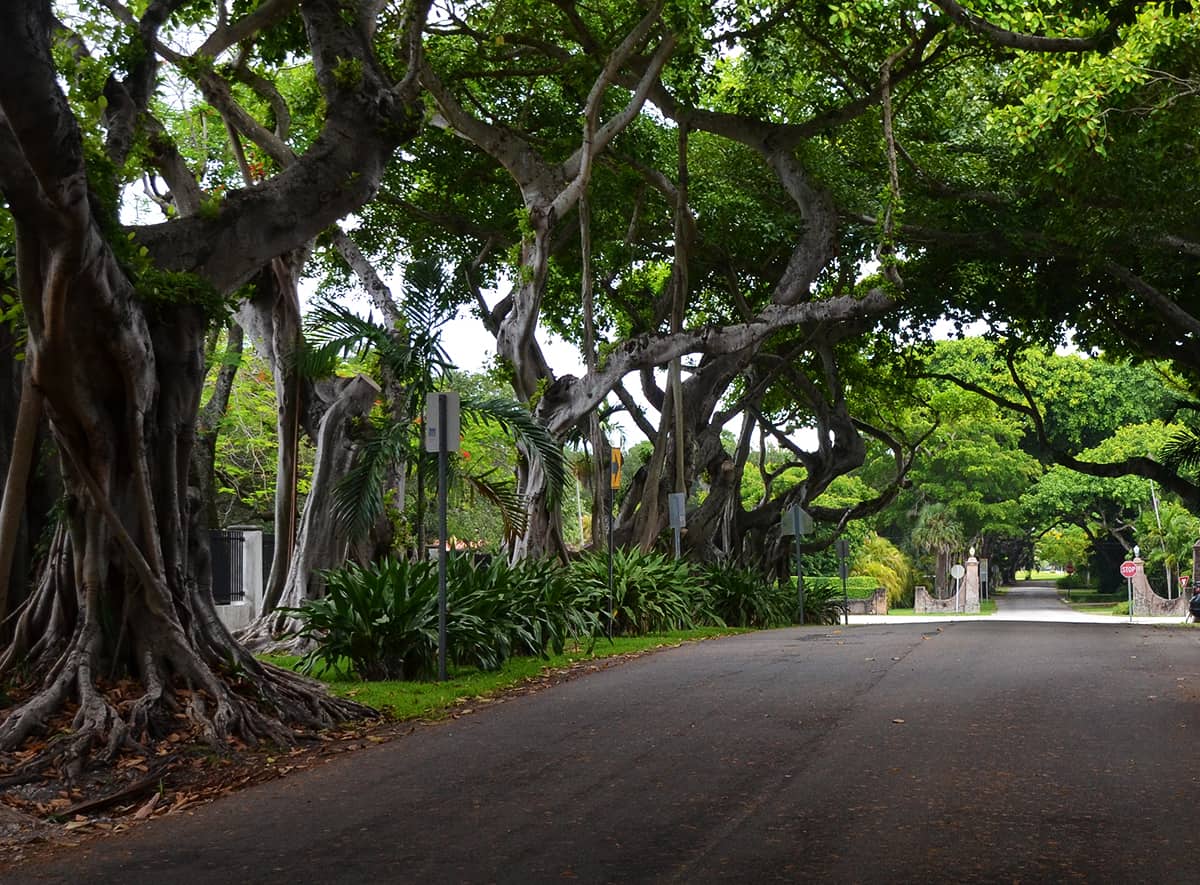
Coral Gables ranks as one of Miami’s iconic neighborhoods, representing the many qualities expected of the Sunshine State’s much-vaunted lifestyle. Its reputation as the poster child community of the City Beautiful Movement that began in the 1920s makes it a primary consideration when considering a luxury real estate location. For those wealthy snowbirds and permanent Florida residents particularly drawn to the Mediterranean Revival style architecture and unsurpassed privacy, the Coral Gables neighborhood fits the bill perfectly. At the same time, home seekers, after a single-family home or condo, are never bored. Old Spanish bungalows amongst Key West Island mansions and sprawling ranches (built in the 1950s and 60s) appeal to all tastes and preferences. Themed penthouse buildings with private-elevator entries to every unit can stand anywhere in the world. See all the Coral Gables homes for sale
Think of docking your yacht a few feet from your living room, with azure blue waters disappearing into the distance behind it. If that’s close to your dream, the Coral Gables neighborhood has it in abundance. Residences on the market for over $50 million leave no doubt that this enclave ranks with Palm Beach Island’s Worth Avenue region, Star Island, and other billionaire famous locales. This Miami pearl is, or at some point, has been home to celebrities Julio Iglesias, Marc Anthony, Dave Barry, Antoine Walker, Alex Rodriguez, and Pat Riley of Miami Heat fame. Shaq O’Neal lives within a figurative stone throw’s distance in the sister-neighborhood of Coconut Grove. In short, the opinion leaders are here and playing, getting the best of what Florida has to offer.
There’s much more to the Gables than meets the eye
If we drill down a bit further, the Gables (as it’s popularly referred to) is, indeed, six districts. The region contains a range of homes priced from $1 million up, with waterfront residences and lots starting at $2 million. It’s footprint features golf tracks that epitomize spectacular vegetation, water views, and sporting challenges rolled into one. Look no further than Santa Maria, Alhambra Circle, Granada, Riviera, and the Biltmore, where you can purchase private memberships with optional conditions. Pedestrian-friendly, the neighborhood is the polar opposite of hectic South Beach featuring pristine, uncrowded, tree-lined sidewalks.
The Coral Gables’ Communities deserve special mention
No article on the Gables would be complete without mention of the different communities, all of which offer different brands of relaxation and comfort across the spectrum mentioned above. Of course, there are commonalities, but when the residents are paying in the millions specific features make a difference:
Cocoplum
A primary Coral Gables neighborhood, with a wide variety of single-family homes currently starting at $2.2 million and going as high as $34 million. The average sold price is $722 per square foot. Some houses date back to 1976, and yet there are others built this year. The smallest is around 3180 square feet and the biggest 18,359 square feet under air. Cocoplum homes for sale
Cutler Oaks Estates
This is a neighborhood dating back to 1991 with single-family homes selling on average at around 50% of Cocoplum at $314 per square foot but still a median price of $2 million. Putting the two metrics together, one can see that houses in this community are 7000 square feet plus. Cutler Oaks Estates homes for sale
Deering Bay
With single-family homes and some condo buildings ranging from $975,000 – $4 million, this community sprung up in 1993 with square footage averaging out at 4,500 square feet. The median price per square foot sold is around $451. Deering Bay homes for sale
Gables by the Sea
One of the most sought after gated community developments built around a boater’s lifestyle. Located on beautiful canals and Biscayne waterways with no bridge interference. The sale price per square foot is over $500, and the average selling price is just over $2 million. Gables by the Sea homes for sale
Gables Estates
Now, this is a community for single-family homes that’s in a different league. Initiated in 1964, the selling price per square foot is 4.5 times the Cocoplum same-metric at $2500. If you are thinking of paying less than $5 million, this is not the hunting ground for you. If you’re a big spender, expect to see residences of over $29 million. The median price – a sobering one – is a touch below $10.2 million. Gables Estates homes for sale
Hammock Lakes
A 1953 part of Coral Gables, with mansions as the favored residence, there’s nothing less than 4500 square feet at an average selling price of $801 per square foot. The median sales price is close to $6.1 million. Hammock Lakes homes for sale
Hammock Oaks
A development started in 1961 and continues to this very day. Single-family homes go for $990,000 to $2.5 million (on the water) with an average of $553 per square foot. You can get a relatively smaller home here (around 2500 square feet) and many at 6600 square feet. Hammock Oaks homes for sale
King’s Bay
One of the more affordable sections of The Gables at the average cost per square foot of $312. Top prices recently are under $1.2 million, and the median price just above $700,000. If this is your starter home and you want to get a foothold in Coral Gables, start looking here. King’s Bay homes for sale
Journey’s end
The single-family homes here are huge – all between 7300 and 8000 square feet @ $750 a square foot average. You need many bucks to live here. It’s been a work in progress since 1971. Journey’s End homes for sale
Old Cutler Bay
This is another old Gables development that kicked off in 1967. It boasts an average cost per square foot of $1000, Known for varied architecture, single-family homes start at $2 million going as high as $16 million. Old Cutler Bay homes for sale
Snapper Creek
A little like Old Cutler Bay but with less pricing steroids. Average single-family home sales priced at $750 per square foot. Prices start at $2000,000 and climb to as high as $10 million. The area is 65 years in the making, having started in 1956. Snapper Creek homes for sale
Sunrise Harbor
An enclave started in 1957, single-family homes are currently on the market for higher than $13 million. It reflects an average sales price per square foot of over $1000. There’s a big price spread, and residences can be found for under $1 million if you look carefully. Sunrise Harbor homes for sale
Tahiti Beach
A jewel of Coral Gables, this is a secured, private, waterfront community containing 26 stunning homes with asking prices going as high as $34 million. There’s nothing less than $6 million. It’s the complete symbol of the lifestyle every Gables resident aspires to. Tahiti Beach homes for sale
Is there any action around Coral Gables?
Don’t get the idea that the Coral Gables Neighborhood closets you in any way. You can be drinking martinis poolside in the morning and dancing the night away in Key Largo after an hour’s drive in your Masserati. Or motorboat to Bimini, a comfortable two-hour stretch. Then don’t forget the fine-dining choices in Miami on the beaches and cultural sections like Little Cuba and the Designer District. If you and your spouse love to shop, iconic brand selections like Porsche, Gucci, Fendi, and Rolex are endless. Find them in malls all over the city and on almost every street close to the ocean. For convenience, we suggest the world-famous Bal Harbour Shops or right on your doorstep at Shops at Merrick Park located in the heart of Coral Gables.


